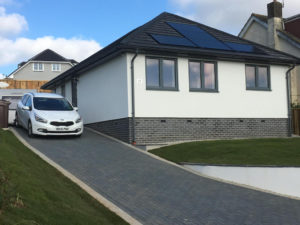Joseph Daniels, founder of Project Etopia asks: Could councils once again be the saviours of first-time buyers?
Housebuilding in Britain has reached a stalemate in recent years. There is a great — and growing — demand for new homes, yet the search for solutions to this ever-deepening crisis never seems to near a conclusion.
The short, sharp truth about UK housing is that we are not building enough of it, and hundreds of thousands of people are locked outside the property market. While there has been a need for urgent answers, most of those in the industry with the power to choose a new way forward instead remain glued to traditional building methods rather than expanding into new technologies and construction techniques.
However, the country’s fortunes may now be changing. Thanks to a loosening of the cuffs that have prevented local authorities investing in new homes, it is councils who now have the opportunity to put themselves at the forefront of a housing revolution by embracing the possibilities presented by new technologies.
Developments in building methods mean modern hi-tech homes can be built quickly and inexpensively through modular technology, where the parts are constructed off-site and delivered to the development once the groundwork is complete. The speed, flexibility and low cost of building a village with modular housing means there is finally an antidote to the housing crisis.
Government funding for those projects could soon be available too. Chancellor Philip Hammond has indicated a desire to prioritise the use of offsite manufacturing techniques to improve productivity and cost-effectiveness and has also pledged £44bn to boost housing delivery across the UK.

Take the lead
But it is leadership as well as money that are needed. The opportunity to realise modular housing developments on a massive scale already exists, and yet housebuilding remains frozen in time.
There is no rapid acceleration in construction, councils remain at the mercy of developers who can cling onto empty land for years at a time, and all the while the population continues to grow, with demand for affordable homes increasing among young families. There is a way to thaw the crisis. The industry’s greatest release for a generation can come from councils, emboldened by their increased spending power and consumer might, spelling out exactly what vision they have for modular building in their areas.
Modular builds offer more flexibility because they are constructed off site, and there is less of an impact on local residents in terms of construction traffic, noise pollution and disruption because the build time is greatly reduced. At a time when councils are on average six years behind their housebuilding targets*, the speed of modular home construction means a 50-home village could be completed in less than a year. An entire home can be completed from the groundwork up in less than eight weeks.
With the ability to address the housing crisis much more quickly than is possible with traditional bricks and mortar builds, modular houses will begin to take the burden off local councils immediately.

Design flexibility
The stereotypical image that modular houses are ugly and of poor quality never really held true — the first modular homes in Britain were apartment blocks built in Liverpool. Although the building materials were still fairly standard, the principle is tried and tested.
Modular homes offer design flexibility and a high quality finish with modern technology at its core — something to be desired, rather than just tolerated. The opportunity to be able to buy a real home, especially one that incorporates modern techniques and technologies is something that many first time buyers simply cannot imagine. But the speed in which they can be constructed means those doors can rapidly start to open.
The high level of new technology installed allows for energy generation and storage which makes them more sustainable than traditional builds, where eco elements do not come as standard. The central focus of promoting a more green and sustainable lifestyle means utility costs are lower and ensures that modular homes are fit for the future.

Embracing modular technology
The attitudes of lenders and investors are limiting the uptake of modular builds because they are stuck to the belief that modular housing does not last. But it will only take a handful of local authorities to embrace the positive alternative that modular builds provide and commission a small group of modular developments before others will surely follow suit. When modular houses are embraced, and investors and aspiring homeowners alike are able to truly understand the level of quality a modular build can provide, the outlook of the British property market will be flipped on its head.
The Government is conducting research into modular homes and technology, and any endorsement will be an added boost for councils concerned about how the developments will be viewed by other authorities and political figures.
Making use of modular methods unlocks more than just speedy house delivery. A primary concern with new housing developments is the lack of accompanying infrastructure, with the best local schools already oversubscribed and GP surgeries at capacity. With a modular development, schools, a GP surgery and space for shops can easily be built alongside the homes using the same techniques. There is even potential for schools to be easily extended, since the modular method means new units can be added to the building within a matter of weeks, alleviating months of construction disruption for teachers and pupils.
A new way of thinking about housing is drastically needed if the gap between property numbers and people needing a home is ever to narrow. The technology to produce modular homes has come on leaps and bounds, and means those houses are now indistinguishable from their brick and mortar counterparts. The factories are ready to produce the homes — councils just need to make the orders.









